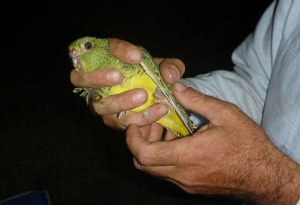Archive
Parrot news! (Night Parrot, Swift Parrot, Orange-bellied Parrot)
Back to posting! This post is about news related to three very rare and unique parrot species.
The first story is about the Night Parrot of Australia, which I wrote about HERE. Night parrots are very elusive, nocturnal parrots from Australia. Sightings are very sporadic and therefore very little is known about them. For a long time, it was even unclear whether or not the species still existed
However, some photos and videos of a night parrot were obtained recently, and you can see some here: http://www.abc.net.au/news/2015-08-10/night-parrot-nature-reserve-created-queensland-endangered-bird/6680392
Since so little is known about these birds, and because they are likely very rare, a new reserve was created to protect them. The location of it is a secret, which is likely for the best so that poachers don’t go after the birds or so that large numbers of birders don’t overwhelm them. One Night Parrot was caught and radio tagged so biologists could monitor its movements.
I am a birdwatcher and biologist and am always thrilled to come across a rare species. I can’t imagine how exciting it would be to find such an incredibly rare and elusive species!

Night Parrot. Picture from http://www.dailymail.co.uk/news/article-3193059/Parrot-feared-extinct-100-years-Australia-Discovery-ground-dwelling-night-parrot-described-holy-grail-moment-scientists.html
Night Parrots look a bit like miniature Kakapos (another nocturnal ground-dwelling parrot) with more yellow, but Night Parrots and Kakapos are actually only distantly related.
One of the methods being used to protect the night parrots involves setting traps for non-native, feral predators (such as cats) that could kill the parrots. There’s more about this here: http://www.theaustralian.com.au/news/health-science/feral-cat-grooming-traps-to-secure-site-for-rare-night-parrots/story-e6frg8y6-1227503351863?sv=f3ace50e5213b8684e9bc91145763cab
Eliminating feral cats is always controversial, but in this case, doing so may end up saving an endangered species.
For another critically endangered Australian parrot, preserving mature forest may be the key to saving it. Swift Parrots are one of two parrots species that undergo routine migrations. The other is the Orange-bellied Parrot. Both of these species breed in Tasmania and spend the non-breeding season in southeast Australia. To travel between mainland Australia and Tasmania, they have to fly across approximately 150 miles of water.
Both species are threatened by habitat loss. However, recent research suggests that preserving mature forests from logging could help conserve the swift parrot. Find out more here: http://www.abc.net.au/news/2015-09-10/forestry-tasmania-urged-to-save-endangered-swift-parrot/6763332

Swift Parrot. Picture from http://www.abc.net.au/news/2015-09-10/forestry-tasmania-urged-to-save-endangered-swift-parrot/6763332
Many parrot species rely on mature forests, as old trees are more likely to contain cavities that parrots use as nests.
The Orange-bellied Parrot is also in serious trouble, in part due to habitat loss. However, disease is now threatening the species, as one adult and several nestlings have tested positive to a virus called psittacine beak and feather disease. The disease can cause deformed feathers and overgrown beaks and can be fatal, especially in wild birds.
Captive-bred Orange-bellied Parrots have been released into the wild and initially it was thought they could have been the source of the virus. However, the virus has not been found in any of the captive-bred birds released, and viruses from wild orange bellies are similar to those that have been found in wild Sulphur-crested Cockatoos. Sulphurs are rare where orange-bellies breed so the virus may have spread to orange bellies from another species.
More information can be found here: http://www.abc.net.au/news/2015-09-14/questions-over-disease-threatening-orange-bellied-parrots/6771828 .

Orange-bellied Parrot. Image from http://www.abc.net.au/news/2015-09-14/questions-over-disease-threatening-orange-bellied-parrots/6771828